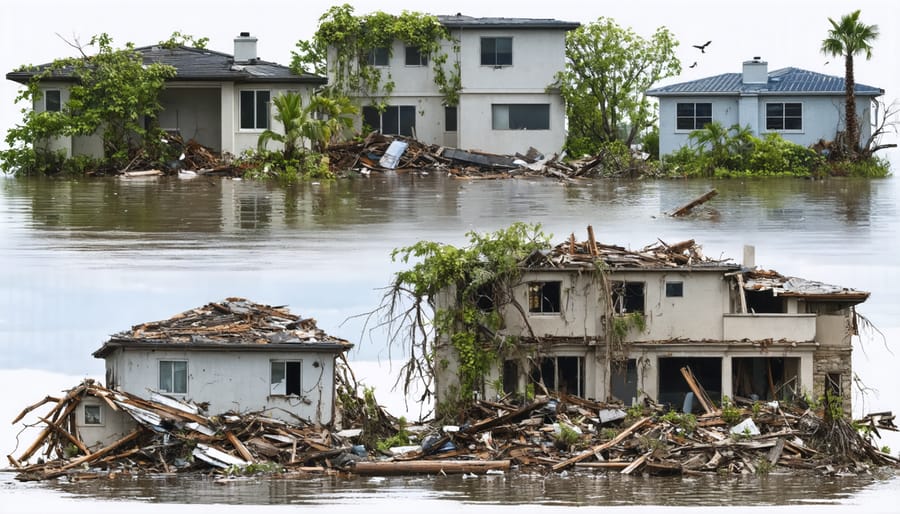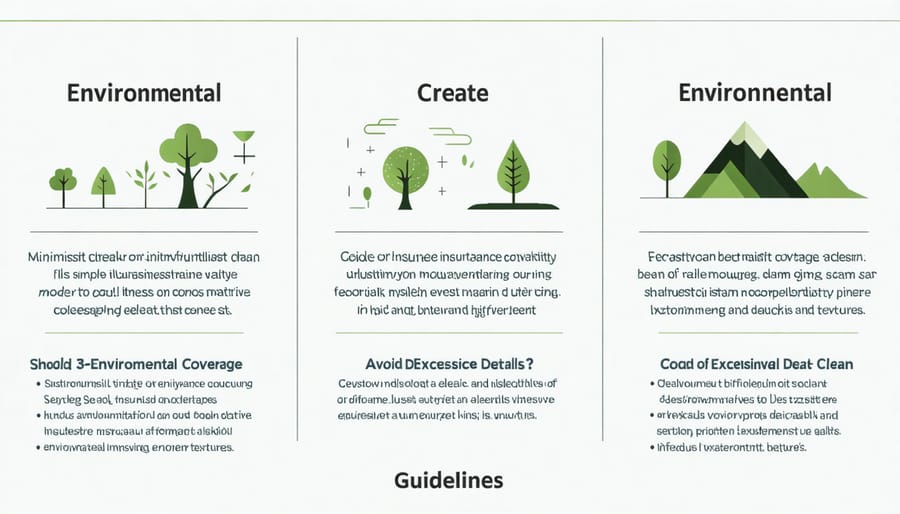In today’s volatile real estate market, property risk insurance stands as the critical shield between successful investment and devastating financial loss. While standard coverage protects against common threats like fire and theft, sophisticated investors recognize that hidden property risks often pose the greatest danger to their portfolios. From climate change-driven natural disasters to emerging cyber threats targeting smart building systems, the landscape of property risk has evolved dramatically over the past decade. Modern property risk insurance solutions combine traditional coverage with innovative protection mechanisms, offering property owners comprehensive security against both established and emerging threats. Understanding these evolving risks and implementing robust insurance strategies isn’t just about protection—it’s about creating sustainable, resilient investment opportunities that can weather any storm, literal or metaphorical.
Common Environmental Risks Threatening Investment Properties
Natural Disaster Risks
Natural disasters pose significant risks to property investments, and their frequency and intensity are increasing due to climate change. Property owners must prepare for natural disasters through comprehensive insurance coverage and risk mitigation strategies.
Floods represent one of the most common and costly natural disasters, affecting properties in both coastal and inland areas. Even properties outside designated flood zones can experience unexpected water damage from severe storms or infrastructure failures. Earthquakes, while less frequent in many regions, can cause catastrophic damage that standard insurance policies typically don’t cover.
Severe storms, including hurricanes, tornadoes, and winter storms, present multiple risks including wind damage, falling trees, and ice accumulation. These events can cause extensive structural damage and often trigger secondary issues like water infiltration or power outages.
Climate change is amplifying these risks, with more frequent extreme weather events and shifting weather patterns creating new vulnerability zones. Insurance providers are responding by adjusting coverage options and premiums, making it crucial for property owners to regularly review and update their policies to ensure adequate protection against evolving natural disaster risks.

Man-Made Environmental Hazards
Man-made environmental hazards pose significant risks to property investments and require specialized insurance coverage. These hazards primarily stem from contamination, pollution, and exposure to toxic substances, which can severely impact property value and habitability.
Common man-made hazards include chemical spills, industrial waste contamination, underground storage tank leaks, and toxic mold growth. Properties near industrial zones or former manufacturing sites are particularly vulnerable to these risks. Even residential properties can face issues from previous land uses, such as dry cleaning operations or gas stations.
Standard property insurance policies typically exclude coverage for man-made environmental hazards, necessitating specialized environmental liability insurance. This coverage helps protect property owners from cleanup costs, legal liability, and property value diminishment resulting from contamination events.
Key considerations when securing environmental hazard coverage include:
– Historical property use and surrounding area activities
– Current and planned property operations
– Proximity to industrial or commercial zones
– Known contamination risks in the area
– Regulatory compliance requirements
Property owners should conduct thorough environmental assessments before purchasing property and maintain appropriate insurance coverage throughout their ownership period. Regular environmental audits and proper documentation can help manage premiums and ensure adequate protection against these risks.

Essential Environmental Risk Insurance Coverage Types
Pollution Legal Liability Insurance
Pollution Legal Liability Insurance (PLL) provides crucial protection for property owners against environmental risks and contamination-related claims. This specialized coverage addresses both sudden and gradual pollution events, offering financial protection for cleanup costs, third-party bodily injury claims, and property damage resulting from contamination.
The policy typically covers a range of pollution scenarios, including chemical spills, underground storage tank leaks, asbestos exposure, mold growth, and soil or groundwater contamination. For real estate investors and property managers, this insurance is particularly valuable when acquiring or managing properties with potential environmental concerns or historical industrial use.
Key benefits include coverage for:
– Site investigation and cleanup costs
– Legal defense expenses
– Business interruption losses due to pollution events
– Third-party claims for bodily injury or property damage
– Transportation-related pollution incidents
– Historical contamination discovered after property purchase
When considering PLL insurance, it’s essential to evaluate your property’s specific risks. Former gas stations, industrial sites, or properties with aging infrastructure may require more comprehensive coverage. The policy terms typically range from one to ten years, with premiums varying based on property type, location, and historical use.
Many lenders now require PLL coverage before financing commercial real estate transactions, making it an increasingly important component of property risk management strategy. Property owners should work closely with experienced insurance brokers to ensure their policy adequately addresses their specific environmental risk exposure.
Natural Disaster Coverage Options
Natural disaster coverage varies significantly depending on the specific risks your property faces. Most standard property insurance policies include basic coverage for certain natural events, but comprehensive climate resilience insurance coverage often requires additional riders or separate policies.
For flood protection, property owners typically need specialized flood insurance, as standard policies rarely cover flood damage. These policies can be obtained through the National Flood Insurance Program (NFIP) or private insurers, with coverage limits and premiums based on your property’s flood zone designation.
Earthquake coverage is another crucial add-on in seismically active regions. This protection typically comes with a separate deductible, usually calculated as a percentage of your property’s value, ranging from 2% to 20%.
Windstorm coverage, particularly important in coastal areas, may require specific endorsements or separate policies. Hurricane-prone regions often have special deductibles triggered only by named storms.
Wildfire protection is typically included in standard policies but may need enhanced coverage in high-risk areas. Some insurers offer additional services like professional firefighting teams or preventive measures.
When selecting coverage, consider your location’s specific risks, historical disaster data, and the property’s vulnerability. Work with an insurance professional to create a comprehensive protection strategy that addresses all potential natural disaster scenarios while remaining cost-effective.
Environmental Impairment Liability Insurance
Environmental Impairment Liability Insurance (EIL) provides crucial protection against gradual environmental damage that standard property insurance policies typically exclude. This specialized coverage addresses risks like soil contamination, groundwater pollution, and toxic material exposure that can develop over time, potentially devastating property values and creating significant liability issues.
For property owners and investors, EIL insurance offers coverage for cleanup costs, third-party bodily injury claims, property damage, and legal defense expenses related to environmental incidents. This becomes particularly important when dealing with properties that have historical industrial use or are located near potentially hazardous facilities.
The policy typically covers both sudden and gradual pollution events, including:
– Chemical seepage into soil or water systems
– Asbestos exposure
– Underground storage tank leaks
– Mold contamination
– Air quality deterioration
What sets EIL apart is its “claims-made” basis, meaning it covers incidents discovered during the policy period, regardless of when the contamination began. This is particularly valuable for properties with unknown historical environmental issues.
Property investors should carefully assess their environmental risks when considering EIL coverage. Factors to consider include:
– Property history and previous uses
– Neighboring property activities
– Local environmental regulations
– Soil and groundwater conditions
– Cost of potential remediation
Premium costs vary based on property type, location, and historical environmental assessments, making it essential to work with insurers who specialize in environmental risks for appropriate coverage tailoring.
Selecting the Right Environmental Risk Insurance

Risk Assessment Strategies
Effective risk assessment for property insurance requires a systematic approach to evaluating potential threats to your real estate investments. Start by conducting a thorough property inspection that examines structural integrity, building systems, and surrounding environmental factors. This baseline assessment helps identify existing vulnerabilities and potential future risks.
Consider the property’s geographic location and its exposure to natural disasters. Study local flood maps, seismic zones, and historical weather patterns to understand environmental risks specific to your area. Modern technology, including satellite imagery and climate modeling tools, can provide valuable insights into long-term environmental trends affecting your property.
Create a comprehensive risk matrix that categorizes threats based on both likelihood and potential impact. Priority should be given to high-probability, high-impact risks when developing insurance coverage strategies. Key areas to evaluate include:
– Building construction materials and age
– Proximity to natural hazards (floodplains, fault lines, wildfire zones)
– Local crime statistics and security measures
– Infrastructure condition and maintenance history
– Adjacent property uses and potential external threats
– Environmental compliance and hazardous materials
Professional risk assessors often use specialized software and analytical tools to quantify risks and recommend appropriate coverage levels. Regular reassessment is crucial, as property conditions and environmental risks can change over time. Consider scheduling annual reviews of your risk assessment strategy to ensure your insurance coverage remains aligned with current property conditions and emerging threats.
Remember that thorough documentation of your risk assessment process can help streamline insurance claims and may even lead to premium discounts from insurers who value proactive risk management.
Cost-Benefit Analysis
When evaluating property risk insurance, conducting a thorough cost-benefit analysis is crucial for making informed decisions about coverage. The primary consideration is comparing annual premium costs against the potential financial impact of property damage or loss.
To perform this analysis effectively, start by calculating your total insurance costs, including premiums, deductibles, and any additional riders. Then, assess the value of your property, considering both the structure and contents. Factor in location-specific risks such as flood zones, wildfire-prone areas, or high-crime neighborhoods, as these elements significantly impact both insurance costs and potential losses.
Consider historical data for your area regarding natural disasters, property crimes, and typical repair costs. For example, if your property is in a hurricane-prone region where average storm damage costs $50,000, paying $2,500 annually for comprehensive coverage might be justifiable.
The analysis should also account for:
– Potential rental income loss during repairs
– Property value appreciation
– Replacement cost versus actual cash value
– Business interruption costs
– Legal liability exposure
Remember that the cheapest option isn’t always the most cost-effective. Under-insurance can lead to devastating financial losses, while over-insurance unnecessarily strains your budget. The sweet spot lies in finding coverage that provides adequate protection while maintaining reasonable costs.
A good rule of thumb is to aim for insurance costs between 0.5% and 1% of your property’s total value, adjusting based on risk factors and coverage needs.
Risk Mitigation and Claims Process
Preventive Measures
Implementing effective preventive measures can significantly reduce your property’s exposure to environmental risks and potentially lower insurance premiums. Start by conducting regular property inspections to identify potential vulnerabilities, such as aging roof systems, outdated electrical wiring, or poor drainage.
Install smart monitoring systems that can detect water leaks, smoke, and unusual temperature changes early. These systems not only prevent extensive damage but also demonstrate proactive risk management to insurers. Maintain proper landscaping to prevent soil erosion and ensure adequate drainage away from the building’s foundation.
For areas prone to natural disasters, consider structural reinforcements like storm shutters, impact-resistant windows, or seismic retrofitting. Develop and regularly update an emergency response plan that includes evacuation procedures and contact information for key service providers.
Keep detailed maintenance records and schedule regular professional inspections of critical systems like HVAC, plumbing, and electrical. Additionally, create a buffer zone around the property by clearing vegetation and maintaining fire-resistant landscaping in wildfire-prone regions. These preventive steps not only protect your investment but can also lead to more favorable insurance terms and reduced premiums.
Claims Navigation
When environmental incidents occur, managing insurance claims effectively becomes crucial for protecting your property investment. Start by immediately documenting the incident with photos, videos, and detailed notes. Contact your insurance provider within 24 hours and maintain a comprehensive record of all communications.
Create a dedicated claims file containing all relevant documentation, including environmental assessment reports, repair estimates, and correspondence with contractors. Be prepared to provide evidence of pre-existing property conditions and maintenance records to support your claim.
Work closely with your claims adjuster, but don’t hesitate to seek independent expert opinions when necessary, especially for complex environmental issues. Keep track of all expenses related to immediate remediation efforts, as these may be reimbursable under your policy.
Remember to review your policy’s specific requirements for environmental claims, as they often have stricter reporting deadlines and documentation requirements than standard property claims. Staying organized and proactive throughout the claims process can significantly improve your chances of a favorable resolution.
In today’s dynamic real estate landscape, comprehensive property risk insurance isn’t just an option – it’s a necessity. Environmental risks continue to evolve and expand, making it crucial for property owners to stay ahead with robust coverage. From natural disasters to human-made environmental hazards, the right insurance strategy can mean the difference between financial security and devastating losses. Remember to regularly review and update your coverage as both property values and environmental risks change over time. Working with experienced insurance professionals who understand real estate-specific challenges can help ensure you have the right mix of coverage for your unique situation. By taking a proactive approach to environmental risk management through comprehensive insurance coverage, you’re not just protecting your property – you’re securing your investment’s future and ensuring peace of mind in an unpredictable world.